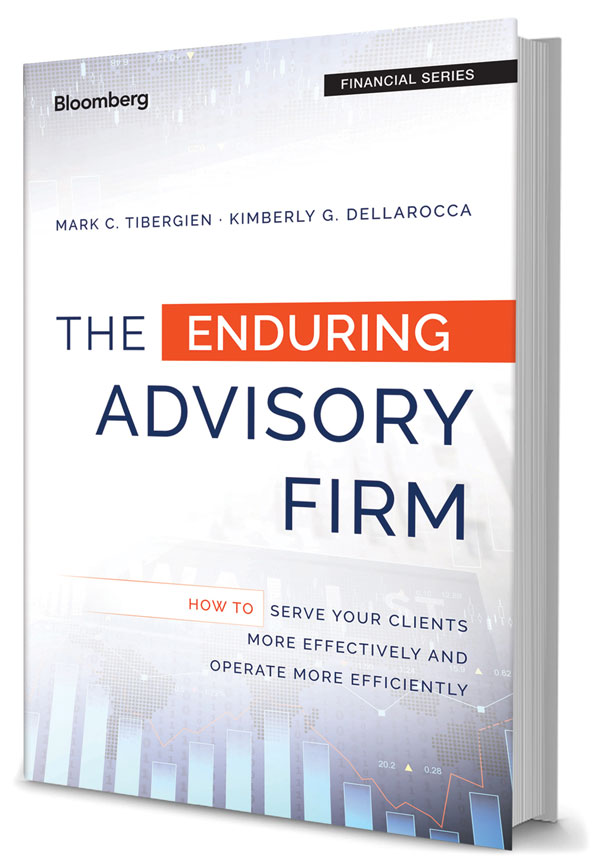Decisions in 3 key areas separate top-performing firms from masses
The following is an excerpt from “The Enduring Advisory Firm: How to Serve Your…
The following is an excerpt from “The Enduring Advisory Firm: How to Serve Your Clients More Effectively and Operate More Efficiently” by Mark C. Tibergien and Kim G. Dellarocca (Bloomberg Press/Wiley, 2016). Mr. Tibergien is chief executive officer of BNY Mellon’s Pershing Advisor Solutions, and Ms. Dellarocca is BNY Mellon’s global head of segment and technology marketing.
Elite advisory firms distinguish themselves in many nuanced ways. But there appear to be three big areas in which the top-performing advisory firms (leading firms) have made the right decisions that helped them truly stand out: human capital management, technology implementation and profitable pricing.
These insights were revealed in “Mission Possible IV,” which Pershing commissioned consulting firm FA Insight to research and write. FA Insight tracked the individual performance of advisory firms between 2008 and 2012, and then segmented the leading firms based on growth rate, profitability and owner’s income as a percentage of revenue. The top-performing firms grew revenue at twice the rate of their peers.
Each of the leading firms demonstrated a level of courage and confidence that was not apparent in the rest of the advisory population. Consider where we were as an economy and an industry in 2008 and how far so many firms fell in terms of assets under management, revenue and profitability. While there were many advisers who believed this downdraft was an aberration and eventually the markets would reinvigorate their businesses, the leading firms in this study went a step further by actually investing ahead of the curve while also adopting better discipline around technology selection, profitability management, people-recruiting and retention.

One data point that reveals this newfound discipline is that leading firms saw overhead costs (expense ratio excluding professional compensation) decrease to 36% of revenue. Meanwhile, the overhead expense ratio for all other independent advisory firms rose to 45% of revenue in 2012. A 9% variance is huge. For example, if your business generated $2 million in annual revenue, you would be spending $180,000 more on overhead than a comparable leading firm.
One consequence of better expense control is that the leading firms produced an operating profit of 29% in 2012, compared to 13% for the rest of the industry on average. For a $2 million practice, that variance means that leading firms had an operating profit of $580,000, compared to $260,000. What I like about this statistic is that it validates the argument that people are an asset on which to get a return and not just a cost to be managed. Clearly, the investment these firms made in human capital paid off.
When surveyed in 2009, almost half the advisory firms that have emerged as leaders said they intended to add head count and were not planning to lay anybody off. For the most part, they made good on this commitment, with the median firm adding two more people for every half-time employee by the average firm.
LIMITED CAPACITY
This reveals a keen understanding by the leading firms as to what ultimately drives growth in the advisory business. The reality is that most advisers suffer from limited capacity, which makes it difficult to pursue or even take on more clients without materially altering the client experience or terminating existing clients. By investing in capacity before their growth occurred, these leading firms were in a better position to take advantage of market movements and the addition of new clients who had become alienated from their previous financial advisers during the downturn.
A subtle shift in who these firms hired also occurred. Instead of perpetuating the old approach of hiring other advisers or “rainmakers,” who may or may not work out, these firms added so-called nonprofessional staff at a lower cost but with superior administrative skills so that their current team of business developers and advisers could become more productive and effective.
(Related read: 2016 Elite RIA Study)
As an example, lead advisers have been able to increase the time they spend with clients to 75%, compared to 52% for the average firm. This increased capacity frees them up to take in even more clients without affecting the experience. And the revenue per professional in the leading firms is $150,000 greater than in the average firm.
It is no coincidence that these fast-growing firms also added professional management, which also freed up advisers to focus on new business opportunities and existing clients while still executing on their business plans.
One area in which professional management contributed greatly to leading firms was in how they deployed their technology. By realizing that what matters is not the number of tools used but rather the way in which they are used, these professional managers introduced disciplined selection processes, emphasized training and focused on improving workflow efficiencies. What is interesting is that while the leading firms showed better profitability and productivity numbers, they spent less of their revenue on technology than the average firm.
In addition to leveraging technology to improve business-to-client processes, the leading firms tended to use technology more effectively to monitor and troubleshoot service delivery. Nearly 70% of the leading firms use time-tracking, CRM and project management software in their businesses today.
The other area of business discipline that professional managers brought to the leading firms was around pricing strategies. Obviously, 2008 and 2009 tested the mettle of all advisers, particularly with respect to their client relationships. Many firms discounted their fees, waived minimums or avoided fee hikes because they were unsure how clients would react. Many were humbled by the market cataclysm and to a degree lost belief that what they were doing was adding value.
Once again demonstrating a contrarian’s courage, the leading firms decided not to compete on price but on value, recognizing that they truly earn their keep in the most difficult of times. In the spirit of calculated aggression, many moved toward premium pricing. By commanding a fair price for value, they not only showed confidence to their clients, but were able to cull out clients who did not perceive the advisory relationship was worth the price.
Leading firms were most aggressive with larger clients with fees on $5 million portfolios being raised by 10 basis point on average, while the other firms in the study reduced their fees by 10 basis points on average for comparable clients. A roughly similar trend occurred on assets above $10 million.
In addition to raising fees on their largest clients, leading firms also strictly imposed fee minimums. This helped avoid the perception that large clients were subsidizing smaller clients and ensured that smaller clients were paying fair value for the advice they were getting. It also ensured that they were able to cover their costs of serving lower-value clients.
Business owners, just like investors, make calculated guesses every day with the hope of a better payoff. In the case of the leading advisory firms, decisions clearly were informed by facts and not swayed by emotions. They positioned themselves well for a strong market upswing, and to capitalize on new business opportunities that would eventually come their way.
They have blazed the path for others who may be more timid about their growth strategies. Obviously, the leading firms made choices when the world was in a trough. Much has changed since the Great Recession began, but the argument for hiring ahead of the curve, deploying technology more intelligently and maintaining pricing discipline still makes sense for growth-minded advisory firms.
BUT ARE YOU SCALABLE?
Common wisdom holds that the advice business is not scalable. While operating leverage may be easier to attain in other industries, such as manufacturing or software development, advisory firms can achieve scale once they reach a certain level of critical mass.
Investopedia defines a scalable company as one that can “improve profit margins while sales volume increases.” Does that description apply to advisory firms?
The 2014 Financial Performance Study of Advisory Firms conducted by InvestmentNews and sponsored by Pershing Advisor Solutions revealed that many growing advisory businesses are seeing margins improve as revenues increase. For example, overhead expenses as a percentage of revenue dropped from a high of 48.1% to 28.9% as advisory firms broke through certain revenue and asset barriers.
The most precipitous decline in the expense ratio was noted when advisory firms became “super ensembles,” defined as an advisory business with at least $10 billion in assets under management and at least $10 million in annual revenue. For the average independent firm, these numbers may seem daunting, but $10 billion of AUM is not beyond the reach of the next generation of financial advisers. Not only does the expense ratio decline as a firm gets bigger, but revenue growth also accelerates with size. Why? Because a larger market presence creates increased efficiency, stronger discipline around business development and the ability to build a brand.
IMPAIRED QUALITY CONTROL
There are risks to growth, however. The pursuit of critical mass can also contribute to cultural dysfunction, defection of employees and impaired quality control. The more the principals in a firm are removed from the daily activities and supervision of specific client engagement, the greater the risk that steps may be neglected, recommendations may be inappropriate and errors may be made.
To protect against self-destruction brought on by growth, advisers must view scale not as a natural byproduct of growth, but as something that occurs only when the leadership is thoughtful about the business they wish to create, systematic in the processes they implement to manage growth and aware of the metrics that indicate when their train is going off the rails.
Advisers must focus on the following key areas if they hope to achieve scale:
• Expansion into new locations
• Examination of workflow and processes
• Recruitment, retention and development of people
• Constant monitoring and measuring of critical ratios
We cite expansion into new locations first because this seems to be the way in which advisers believe they can grow quickly — by merging in or acquiring another firm in a different city. The first question one should ask is whether the firm can achieve critical mass in the new location itself. Based on our experience, it appears that a reasonable level of operating efficiency occurs when an advisory firm generates in excess of $10 million of annual revenue (a proxy for staffing, assets and clients in most cases). At this level, an advisory firm has sufficient redundancies and capacity to grow. When advisers open an office in a new location with no plans to get it to critical mass, they become vulnerable. The loss of a key client or key employee or partner in the remote location may force them to close shop as quickly as they opened the doors.
Streamlining workflow and processes probably constitutes the easiest way to manage growth. Most advisory firms have been doing the same thing the same way since they began. When they reexamine their approach, they often discover many functions that are repeated over and over again and therefore could be automated or done by a lower-level associate. An improved workflow enables advisers to lower their cost of labor and increase their efficiency, both of which help to reduce operating expenses within the firm.
Talent retention and development may be the area of greatest risk. All businesses tend to lose some focus as new people join the firm. To counter this, firms must implement a conscious strategy around training and inculcating the values that leadership holds dear.
(Related read: Big data for analyzing adviser businesses, clients part of TD’s fintech strategy for 2017)
As with any investment, it is important to define success and to measure performance against those metrics. Even more critical is the need to establish leading indicators for the firm in general as well as for all branch offices or divisions. In addition to tracking operating profit margin and gross profit margin, it is helpful to monitor other ratios such as clients-to-staff, revenue-per-staff, revenue-per-client, error rates, growth rates and attrition rates.
It seems likely that the advisory profession will soon resemble the accounting profession, with a small number of national firms, a larger number of regional and local firms, and the smallest number of solo practitioners. While the advisory business in general is profitable, there comes a point in the life cycle of a firm when its owners have to commit to growing or to staying small. Those caught in the middle never achieve scale or operating efficiency because they are too big and too small at the same time.
Fortunately, current models of success demonstrate how larger enterprises can not only grow efficiently, but also serve their clients effectively.
Learn more about reprints and licensing for this article.







